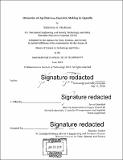Dynamics of agribusiness decision making in Uganda
Author(s)
Picchione, Katherine R
DownloadFull printable version (15.20Mb)
Other Contributors
Technology and Policy Program.
Advisor
Jarrod Goentzel.
Terms of use
Metadata
Show full item recordAbstract
Uganda is a developing country in East Africa that faces high poverty rates among a confluence of socio-political issues. In the pursuit of fiscal and political stability, international development organizations are working to create an environment in which business prospers and livelihoods are resilient. Agriculture, in particular, employs 75% of the population and accounts for 85% of Uganda's export earnings. However, many smallholder farmers experience volatile cashflows around crop cycles. Consequently, farmer livelihoods are vulnerable to uncertain growing conditions, market price fluctuations, and financial shocks, such as hospital bills or school fees. Subject to a high degree of uncertainty, it is difficult for farmers to improve their quality of life through agriculture alone. Agribusinesses--commodity traders in particular-are well positioned to help farmers access knowledge, goods, and services to increase yields and improve crop quality In some cases, provision of knowledge, goods, and services aligns with an agribusiness's regular profit-earning strategies. For example, some traders provide farmers with financing to purchase seeds and fertilizer at the beginning of the growing season; the farmer benefits from less cash volatility while the trader ensures crops will be available at harvest. This thesis explores the extent to which trader business strategies might be leveraged to mutually benefit agribusiness growth and farmer livelihoods. Specific goals were to identify common business strategies used by agricultural commodity traders and understand the mechanisms by which certain business strategies also benefit farmers. Semi-structured interviews and subsequent qualitative analysis shed light on the types of business strategies traders adopt. System dynamics modeling was then used to explain why certain strategies can be mutually beneficial. The combination of qualitative and quantitative methods yielded unique insight on ways mutually-beneficial behavior might be encouraged.
Description
Thesis: S.M. in Technology and Policy, Massachusetts Institute of Technology, School of Engineering, Institute for Data, Systems, and Society, Technology and Policy Program, 2018. Cataloged from PDF version of thesis. Includes bibliographical references (page 58).
Date issued
2018Department
Massachusetts Institute of Technology. Engineering Systems Division; Massachusetts Institute of Technology. Institute for Data, Systems, and Society; Technology and Policy ProgramPublisher
Massachusetts Institute of Technology
Keywords
Institute for Data, Systems, and Society., Technology and Policy Program.